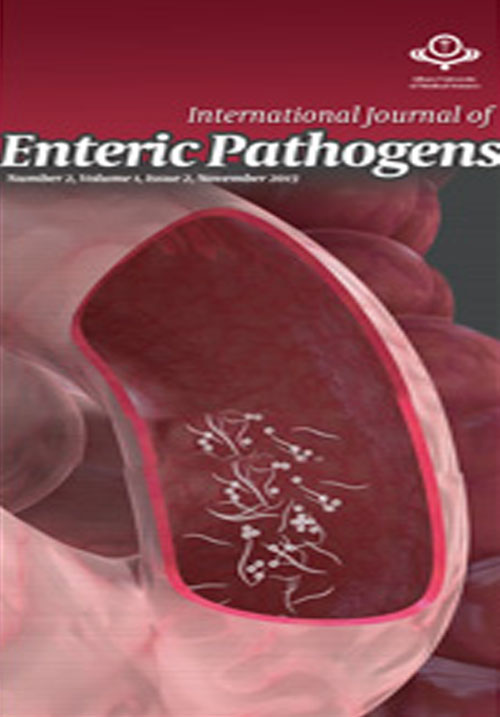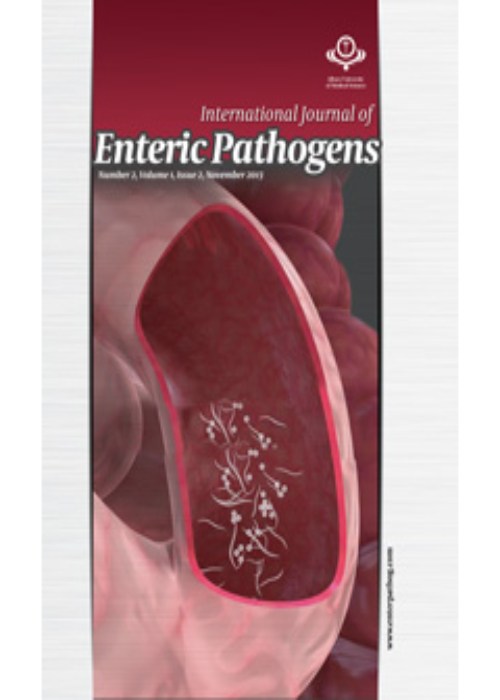فهرست مطالب

International Journal of Enteric Pathogens
Volume:9 Issue: 3, Aug 2021
- تاریخ انتشار: 1401/05/11
- تعداد عناوین: 8
-
-
Pages 83-89Background
Toxoplasmosis, a significant zoonotic parasitic disease with serious health problems, is caused by apicomplexan protozoa, Toxoplasma gondii. Evidence has shown that Toxoplasma can also lead to psychological diseases.
ObjectivesThe aim of this study was to collect information on the relationship between anxiety and toxoplasmosis.
Materials and MethodsPubMed, Google Scholar, Noormags, and Magiran databases were searched for studies published from 2010 to October 2020. Studies that assessed the relationship between toxoplasmosis/toxoplasma and anxiety were included in the analysis. Synthesis of the results was the primary strategy for data analysis.
ResultsAccording to the inclusion and exclusion criteria, 16 articles were selected. They had been conducted in Iran, the USA, Turkey, the Czech Republic, Finland, Mexico, Austria, and Denmark. In general, the results of 8 out of 11 investigated human studies indicated that T. gondii infection was associated with anxiety. Moreover, five of them were non-human studies, and most of them showed that T. gondii caused anxiety-related symptoms.
ConclusionThe results of most studies showed that toxoplasmosis could be associated with anxiety. However, more studies are needed to look closely at how anxiety relates to this parasite.
Keywords: Toxoplasma, Toxoplasmosis, Anxiety, Mentalhealth -
Pages 90-93Background
Echinococcus granulosus is one of the most important pathogens in medicine. This parasite is able to cause a hydatid cyst in humans, which causes various human and financial losses annually.
ObjectiveThis study focused on determining the polymorphism of antigen B (AgB) of E. granulosus in the human and animal samples of Alborz province.
Materials and MethodsIn this study, 50 samples of the hydatid cyst fluid (HCF), 10 human samples, and 40 sheep samples were collected, then the DNA was extracted from the samples. During the polymerase chain reaction (PCR) process, the corresponding fragment was replicated in the AgB gene. Subsequently, PCR-single-strand conformation polymorphism (SSCP) was performed to investigate genetic diversity.
ResultsAll 50 isolates used in this study showed the AgB in 350 bp after conducting PCR. In addition, all isolates demonstrated similar band patterns after the PCR-SSCP assay.
ConclusionIn 50 isolates, one banding pattern was observed after PCR-SSCP, while no polymorphism was detected in any of the isolates.
Keywords: Echinococcusgranulosus, Antigen B, Polymorphism, PCR-SSCP -
Pages 94-100Background
Mycoplasma strains are frequently found in the human urogenital tract and are mainly associated with bacterial vaginosis (BV) which has several adverse outcomes including infertility, preterm delivery, and abortion. The prevalence of BV caused by Mycoplasma species could be associated with different epidemiological factors such as ethnicity, socioeconomic status, sexual activity, and age.
ObjectiveThis study aimed to investigate the prevalence of BV caused by Mycoplasma hominis and to examine its association with several epidemiological factors.
Materials and MethodsA total number of 110 married, non-pregnant women in the 18-45 age range and with BV referring to the healthcare centers of Falavarjan, Isfahan province, Iran were included in this study. BV was diagnosed based on the Amsel criteria, and the polymerase chain reaction (PCR) was used for detecting M. hominis. Then, the association of several epidemiologic factors with the presence of M. hominis was examined.
ResultsAccording to the study results, 15.4% of patients (group 1, n=17) were positive for M. hominis infection, while the remaining ones (group 2, n=93) were negative for this pathogen. Statistical analyses showed no significant difference between the two groups in terms of age range, job, education level of the subjects and their husbands, history of birth delivery and abortion, number of sexual intercourses per week, daily vaginal wash, body mass index (BMI), socioeconomic status, contraception method, and positive whiff test. However, a higher prevalence of M. hominis infection was observed among the women with previous deliveries ≥2, which was significantly different from the prevalence of non-M. hominis infection. Moreover, a significant association of M. hominis infection with the pH of vaginal discharge and presence of clue cells was detected.
ConclusionAn association was found between M. hominis infection and previous deliveries among the studied women, while other epidemiological factors were discovered not to be important determinants in this regard.
Keywords: Mycoplasma, Bacterial vaginosis, Polymerasechain reaction -
Pages 101-107Background
Probiotic products contain metabolites that have positive effects on the intestinal microorganisms and well-being of the host as well as possess antimicrobial properties.
ObjectiveThis study aimed to investigate the antifungal activities of the water-soluble peptides (WSPs) found in ewe and cow milk kefir fermented by the traditional kefiran of Semnan (Semnan province, Iran).
Materials and MethodsKefir samples were prepared by inoculating Iranian traditional kefiran into pasteurized milk. WPSs were extracted and antifungal activity was evaluated.
ResultsDuring the 28-day storage, the concentration of the amino acids increased except for a decrease detected in the concentration of arginine, aspartic acid, cysteine, and glycine; and the total amino acid concentration in ewe milk and kefir was higher than that in cow’s milk and kefir. The WSPs of both kefir samples showed considerable inhibitory activities against the growth of Candida albicans and Aspergillus niger, but Penicillium sp. had the lowest sensitivity when treated with WSPs. The antifungal activity of WSPs of ewe kefir was significantly higher than that of cow kefir. The highest growth inhibitory potential of WSPs between two kefir samples was found for C. albicans. The antifungal potential of WSPs of ewe kefir was considerably higher than that of cow kefir.
ConclusionThe higher antifungal potential of ewe kefir was likely associated with the high concentration of protein, extensive degradation of proteins, and diversity of amino acids produced during the fermentation.
Keywords: Antifungal, Cow, Ewe, Kefir, Peptide -
Pages 108-113Background
Toxocariasis is a parasitic disease with global distribution. Many paratenic or transport hosts have been identified as the sources of infection, including vertebrates such as birds and humans. The definitive hosts of Toxocara are dogs and cats whose parasites live in their guts. Hence, the diagnosis of the disease in these animals is important.
ObjectiveThe present study was performed using the loop-mediated isothermal amplification (LAMP) method to diagnose toxocariasis.
Materials and MethodsIn the present study, 60 samples of pet feces were collected and subsequently evaluated by direct smear, formalin-ether, and LAMP.
ResultsToxocara infection in dogs by microscopic and formal ether methods and LAMP method was 10% and 13.3%, respectively, while feline infection with this parasite was not observed either microscopically or molecularly.
ConclusionThe present findings revealed that pet dogs can be considered as a source of infection for humans. Therefore, it is recommended that animal owners receive the necessary training to prevent the risks of transmitting zoonotic diseases.
Keywords: Toxocara species, Iran, LAMP, Pet dogs -
Pages 114-116
Non-Hodgkin’s lymphoma includes 60% of lymphoma cases in children and adolescents. Burkitt’s lymphoma and diffuse large B-cell lymphoma (DLBCL) patients usually have intra-abdominal tumors. Non-Hodgkin’s lymphoma (NHL) may present as retroperitoneal fibrosis (RF). In the present paper, a 7-year-old boy was reported who was hospitalized in our hospital because of stomachache, vomiting, and weight loss. In the patient’s history, it was found that 3 weeks ago, the patient complained of flank pain and suspected kidney stones, but urethroscopy revealed that he did not have kidney stones. After admission to our hospital, upon the examination of the abdomen, we noticed a palpable mass in the patient’s epigastric region. Diagnostic laparoscopy was performed, and a large number of hard lesions similar to fibrosis were detected in the mesogastric region, the first part of the small intestine, the head of the pancreas, and the liver. Finally, DLBCL was diagnosed in this patient.
Keywords: Retroperitoneal fibrosis, Ormond’s disease, Lymphoma, Diffuse large B-celllymphoma -
Pages 117-123Background
There has been a growing concern about the potential transmission of Staphylococcus aureus strains among human and animal species through the consumption and handling of foods of animal origin.
ObjectiveThe present study aimed to determine the source and possible route of milk and dairy contamination in Khuzestan province of Iran.
Materials and MethodsA total of 150 raw cow’s milk and 50 traditional cheese samples were collected from local markets in different cities of Khuzestan province, Iran. Presumptive colonies on Baird Parker Agar were subjected to the Polymerase Chain Reaction assay in order to identify the Staphylococcus genus, thermonuclease gene specific for S. aureus, enterotoxigenic gene (sea), and coa gene for coagulase gene. Moreover, biotyping of S. aureus strains was implemented based on Devriese’s system, and the antibiotic susceptibility testing (five antibiotics) was carried out.
ResultsOverall, 80 Staphylococcus spp. was isolated from the samples. The PCR was performed and, as the result, 23 S. aureus were confirmed, out of which 2 isolates (8.6%) belonged to the human ecovar and 17 isolates (73.9%) belonged to the non-host specific (NHS) biotype, whereas 4 isolates (17.3%) remained unclassified. Furthermore, sea gene and coagulase genes were detected in 3 and 22 isolates, respectively. The rates for contamination with S. aureus in milk and in cheese were 15% (19 samples) and 8% (4 samples), respectively. Overall, 4%, 9%, 17%, 35%, and 56% of isolates were found resistant to gentamicin, erythromycin, oxacillin, trimethoprim, and penicillin, respectively.
ConclusionThe local milk and cheese supplied in the given area were contaminated with antibiotic-resistant and enterotoxigenic staphylococci. Therefore, it was recommended that the supply chain of these materials should be carefully monitored in order to prevent the complications caused by the contamination with these ecovars.
Keywords: Dairy, Food poisoning, Toxin, Staphylococcus aureus -
Pages 124-130Background
Inflammation plays an important role in the pathogenesis of diseases such as atherosclerosis and other inflammatory disorders. The inflammatory markers impose a considerable cost on the health system. Recently, neutrophil to lymphocyte ratio (NLR) has been shown to be involved in the prediction of coronary artery disease (CAD).
ObjectivesThis study was conducted to clarify the potential relationship between NLR and the inflammatory extent of CAD.
Materials and MethodsPatients with ST-elevation myocardial infarction (STEMI) or stable angina who underwent primary or elective percutaneous coronary intervention (PCI), respectively, were included in this cross-sectional study. Patients with hematologic disorders, recent or active infectious or inflammatory diseases, history of malignancy, and history of treatment with immunosuppressive drugs were excluded from the study. Gensini and SYNTAX scores were calculated for each patient as an indicator of the extent of CAD. Demographic and clinical characteristics were obtained through a questionnaire and NLR was calculated using laboratory results.
ResultsA total of 446 patients (223 patients in each group) fulfilled the inclusion criteria. NLR had a significant relationship with Gensini score in both stable angina and STEMI patients. Gensini and SYNTAX scores correlated significantly with NLR; however, the correlation was weaker for SYNTAX score. After adjustment for confounding factors, including age and hypercholesterolemia, only one trend remained for the Gensini scores.
ConclusionNLR showed a stronger correlation with Gensini score than SYNTAX score. Our findings are in accordance with previous studies, which show that NLR has a relationship with the extent of CAD. Further studies are required for reaching a definite conclusion. The idea of this study may be useful for the investigation of other inflammatory diseases.
Keywords: Neutrophil tolymphocyte ratio, Gensiniscore, SYNTAX score, Coronary artery disease, Percutaneous coronaryintervention, Stableangina, ST-elevationmyocardial infarction, Inflammatory disorders


